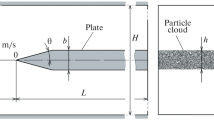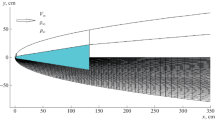Abstract
The problem of interaction of gas-dust flows with solid surfaces arose in connection with the study of the motion of aircraft in a dusty atmosphere [1–2], the motion of a gas suspension in power generators, and in a number of other applications [3]. The presence of a disperse admixture may lead to a significant increase in the heat fluxes [4] and to erosion of the surface [5]. These phenomena are due to the joint influence of several factors — the change in the structure of the carrier-phase boundary layer due to the presence of the particles, collisions of the particles with the surface, roughness of the ablating surface, and so forth. This paper continues an investigation begun earlier [6–7] into the influence of particles on the structure of the dynamical and thermal two-phase boundary layer formed around a blunt body in a flow. The model of the dusty gas [8] has an incompressible carrier phase. The method of matched asymptotic expansions [9] is used to obtain the equations of the two-phase boundary layer. In the frame-work of the refined classification made by Stulov [6], it is shown that the form of the boundary layer equations is different in the presence and absence of inertial precipitation of the particles. The equations are solved numerically in the neighborhood of the stagnation point of the blunt body. The temperature and phase velocity distributions in the boundary layer, and also the friction coefficients and the heat transfer of the carrier phase are found for a wide range of the determining parameters. In the case of an admixture of low-inertia particles that are not precipitated on the body, it is shown that even when the mass concentration of the particles in the undisturbed flow is small their accumulation in the boundary layer can lead to a sharp increase in the thermal fluxes at the stagnation point.
Similar content being viewed by others
Literature cited
A. P. Vasil'kov, “The neighborhood of the stagnation point of a blunt body in a hypersonic two-phase flow,” Izv. Akad. Nauk SSSR, Mekh. Zhidk. Gaza, No. 5, 121 (1975).
S. V. Peigin, “Hypersonic three-dimensional viscous shock layer in a two-phase flow,” Prikl. Mat. Mekh., No. 2, 254 (1984).
Z. R. Gorbis, Heat Transfer and Hydrodynamics of Disperse Continuous Flows [in Russian], Energiya, Moscow (1970).
D. T. Hove and E. Taylor, “Stagnation region heat transfer in hypersonic particle environments,” AIAA J.,14, 1486 (1976).
A. V. Vasin and Yu. V. Polezhaev, “Mass loss in the case of combined erosion and thermal action of a two-phase flow,” Izv. Akad. Nauk SSSR, Mekh. Zhidk. Gaza, No. 1, 120 (1984).
V. P. Strulov, “Equations of a laminar boundary layer in a two-phase medium,” Izv. Akad. Nauk SSSR, Mekh. Zhidk. Gaza, No. 1, 51 (1979).
I. M. Zheleva, Z. D. Zapryanov, A. N. Osiptsov, and V. P. Stulov, “Flows of disperse mixtures under conditions of velocity disequilibrium of the particles,” Usp. Mekh.,5, 183 (1982).
F. Marble, “Dynamics of dusty gases,” in: Mechanics [Periodic Collection of Translations of Non-Soviet Papers], No. 6 (1971), pp. 48–89.
J. D. Cole, Perturbation Methods in Applied Mathematics, Blaisdell, Waltham, Mass. (1968).
V. M. Voloshchuk, Introduction to the Hydrodynamics of Large-Particle Disperse Aerosols [in Russian], Gidrometeoizdat, Leningrad (1971).
R. I. Nigmatulin, Fundamentals of the Mechanics of Heterogeneous Media [in Russian], Nauka, Moscow (1978).
H. Schlichting, Boundary Layer Theory, McGraw-Hill, New York (1968).
Yu. M. Tsirkunov, “Influence of a viscous boundary layer on particle precipitation from a gas suspension flowing past a sphere,” Izv. Akad. Nauk SSSR, Mekh. Zhidk. Gaza, No. 1, 59 (1982).
A. N. Osiptsov, “Investigation of regions of unbounded growth of the particle concentration in disperse flows,” Izv. Akad. Nauk SSSR, Mekh. Zhidk. Gaza, No. 3, 46 (1984).
N. E. Kochin, I. A. Kibel', and N. V. Roze, Theoretical Hydrodynamics, New York (1964).
Author information
Authors and Affiliations
Additional information
Translated from Izvestiya Akademii Nauk SSSR, Mekhanika Zhidkosti i Gaza, No. 5, pp. 99–107, September–October, 1985.
I thank V. P. Strulov for a discussion.
Rights and permissions
About this article
Cite this article
Osiptsov, A.N. Boundary layer on a blunt body in a flow of dusty gas. Fluid Dyn 20, 750–757 (1985). https://doi.org/10.1007/BF01050089
Received:
Issue Date:
DOI: https://doi.org/10.1007/BF01050089




